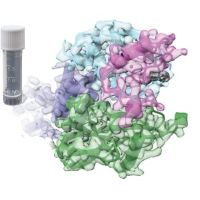Specification
| Organism | Homo sapiens (Human) |
| Expression Host | E.coli |
| Tag Info | N-terminal 6xHis-tagged |
| Purity | Greater than 85% by SDS-PAGE |
| Uniprot ID | Q8N884 |
| Gene Names | CGAS |
| Alternative Names | 2'3'-cGAMP synthase Mab-21 domain-containing protein 1 |
| Expression Region | Partial(161-522aa ) |
| Molecular Weight | 48.3 kDa |
| Protein Sequence | GASKLRAVLEKLKLSRDDISTAAGMVKGVVDHLLLRLKCDSAFRGVGLLNTGSYYEHVKISAPNEFDVMFKLEVPRIQLEEYSNTRAYYFVKFKRNPKENPLSQFLEGEILSASKMLSKFRKIIKEEINDIKDTDVIMKRKRGGSPAVTLLISEKISVDITLALESKSSWPASTQEGLRIQNWLSAKVRKQLRLKPFYLVPKHAKEGNGFQEETWRLSFSHIEKEILNNHGKSKTCCENKEEKCCRKDCLKLMKYLLEQLKERFKDKKHLDKFSSYHVKTAFFHVCTQNPQDSQWDRKDLGLCFDNCVTYFLQCLRTEKLENYFIPEFNLFSSNLIDKRSKEFLTKQIEYERNNEFPVFDEF |
| Form | Liquid or Lyophilization |
| Buffer | The default storage buffer is Tris/PBS-based buffer, 5%-50% glycerol if the delivery form is liquid. The lyophilization buffer is Tris/PBS-based buffer, 6% Trehalose, pH 8.0 if the delivery form is lyophilized powder. Please contact us if you have any special requirment. |
| Reconstitution | Please reconstitute protein in deionized sterile water and we recommend that briefly centrifuge thevial prior to opening the vial .We recommend aliquot for long-term storage at -20℃/-80℃. |
Background
| Relevance | Nucleotidyltransferase that catalyzes the formation of cyclic GMP-AMP (cGAMP) from ATP and GTP and plays a key role in innate immunity (PubMed:23258413, PubMed:23707061, PubMed:23722159, PubMed:24077100, PubMed:25131990, PubMed:29976794, PubMed:30799039). Catalysis involves both the formation of a 2',5' phosphodiester linkage at the GpA step and the formation of a 3',5' phosphodiester linkage at the ApG step, producing c[G(2',5')pA(3',5')p] (PubMed:28363908, PubMed:28214358). Acts as a key cytosolic DNA sensor, the presence of double-stranded DNA (dsDNA) in the cytoplasm being a danger signal that triggers the immune responses (PubMed:28363908). Binds cytosolic DNA directly, leading to activation and synthesis of cGAMP, a second messenger that binds to and activates TMEM173/STING, thereby triggering type-I interferon production (PubMed:28363908, PubMed:28314590). Preferentially recognizes and binds curved long DNAs (PubMed:30007416). In contrast to other mammals, human CGAS displays species-specific mechanisms of DNA recognition and produces less cyclic GMP-AMP (cGAMP), allowing a more fine-tuned response to pathogens (PubMed:30007416). Has antiviral activity by sensing the presence of dsDNA from DNA viruses in the cytoplasm (PubMed:28363908). Also acts as an innate immune sensor of infection by retroviruses, such as HIV-1, by detecting the presence of reverse-transcribed DNA in the cytosol (PubMed:23929945). Detection of retroviral reverse-transcribed DNA in the cytosol may be indirect and be mediated via interaction with PQBP1, which directly binds reverse-transcribed retroviral DNA (PubMed:26046437). Also detects the presence of DNA from bacteria, such as M.tuberculosis (PubMed:26048138). cGAMP can be transferred from producing cells to neighboring cells through gap junctions, leading to promote TMEM173/STING activation and convey immune response to connecting cells (PubMed:24077100). cGAMP can also be transferred between cells by virtue of packaging within viral particles contributing to IFN-induction in newly infected cells in a cGAS-independent but TMEM173/STING-dependent manner (PubMed:26229115). In addition to antiviral activity, also involved in the response to cellular stresses, such as senescence, DNA damage or genome instability (PubMed:28738408, PubMed:28759889). Acts as a regulator of cellular senescence by binding to cytosolic chromatin fragments that are present in senescent cells, leading to trigger type-I interferon production via TMEM173/STING and promote cellular senescence (By similarity). Also involved in the inflammatory response to genome instability and double-stranded DNA breaks: acts by localizing to micronuclei arising from genome instability (PubMed:28738408, PubMed:28759889). Micronuclei, which as frequently found in cancer cells, consist of chromatin surrounded by its own nuclear membrane: following breakdown of the micronuclear envelope, a process associated with chromothripsis, CGAS binds self-DNA exposed to the cytosol, leading to cGAMP synthesis and subsequent activation of TMEM173/STING and type-I interferon production (PubMed:28738408, PubMed:28759889). Acts as a suppressor of DNA repair in response to DNA damage: translocates to the nucleus following dephosphorylation at Tyr-215 and inhibits homologous recombination repair by interacting with PARP1, the CGAS-PARP1 interaction leading to impede the formation of the PARP1-TIMELESS complex (PubMed:30356214). |
| Involvement in Disease | |
| Subcellular Location | |
| Protein Families | |
| Tissue Specificity | CGAS |
QC Data
| Note | Please contact us for QC Data |
| Product Image (Reference Only) |  |

